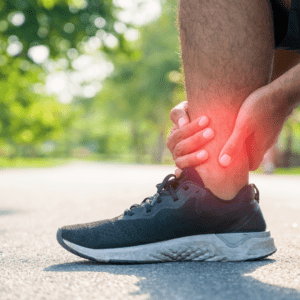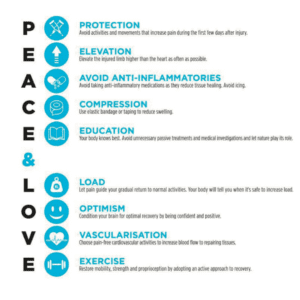Understanding Lateral Ankle Sprains Through the PEACE & LOVE Principles: A Holistic Approach to Recovery
In this blog, we’ll break down the grades of ankle sprains, explain the symptoms of each, and guide you on how to treat them based on severity. This knowledge will empower you to recover faster and with a clear understanding of what’s happening in your body.
What is an Ankle Sprain?
Grade 1 Ankle Sprain: Mild
A Grade 1 sprain is the least severe form of ankle sprain. It involves mild stretching or a slight tear of the ligament fibers, but the ligament remains largely intact.
Symptoms:
- Mild pain and tenderness around the ankle.
- Little to no swelling.
- Mild bruising, if any.
- Slight discomfort or stiffness, but the person can usually walk without much difficulty.
A Grade 1 sprain typically heals within 1-2 weeks with appropriate care.
Grade 2 Ankle Sprain: Moderate
A Grade 2 sprain is more significant than a Grade 1 sprain. It involves a partial tear of the ligament, leading to more noticeable symptoms and greater difficulty walking.
- Moderate to severe pain, especially when trying to move or bear weight on the ankle.
- Swelling and bruising are more pronounced than in a Grade 1 sprain.
- Difficulty walking, with the person favoring the injured foot.
- Instability in the ankle, as the ligament is partially torn, making the joint feel weak.
Grade 2 sprains can take 3-6 weeks to heal, depending on the severity of the ligament damage.
Grade 3 Ankle Sprain: Severe
A Grade 3 sprain is the most severe and involves a complete tear or rupture of the ligament. This is a serious injury that can cause significant instability in the ankle joint and may require surgical intervention in some cases.
- Severe pain at the time of injury, which may subside once the injury settles but is often replaced by intense discomfort when attempting to move the ankle.
- Significant swelling and bruising, often extending beyond the ankle.
- Complete inability to bear weight or walk without crutches.
- A feeling of “instability” in the ankle, as the joint is no longer held together properly by the torn ligament.
- A visible deformity or abnormal positioning of the ankle joint (in extreme cases).
A Grade 3 sprain can take anywhere from 2-3 months or longer to fully recover, and even longer if surgery is required.
Recovery using the PEACE & LOVE approach
Recovery from a lateral ankle sprain requires more than just rest and ice. A holistic, thoughtful approach is necessary to ensure that the body heals correctly and efficiently. One such method is the PEACE & LOVE approach, a modern framework that blends traditional rehabilitation with a focus on care and long-term well-being.
PEACE – The first phase of healing
-
P – Protection:
Immediately after the injury, it’s crucial to protect the injured ankle from further damage. Unload or restrict movement for 1-3 days to minimise risk of aggravating the injury site. Rest should be minimised as prolonged rest can compromise the strength and tissue quality. Pain signals should guide the cessation of protection. -
E – Elevation:
Elevating the ankle above the level of the heart helps reduce swelling by promoting fluid drainage. You can do this by propping the foot on pillows while resting. This simple action will help reduce inflammation and improve circulation, facilitating the healing process. -
A – Avoiding Anti-Inflammatory Medications (If Possible):
While it’s tempting to reach for anti-inflammatory drugs like ibuprofen, there is growing evidence suggesting that inflammation is a necessary part of healing. Mild inflammation helps the body repair damaged tissue. By using anti-inflammatories in the early stages of healing (first 0-48 hours) the can lead to impaired tissue repair down the track. -
C – Compression:
Compression can help prevent excessive swelling by applying gentle pressure. Using an elastic bandage or compression wrap can help keep the swelling in check and provide support to the injured area. Just ensure that it’s not too tight, as this could impair circulation. -
E – Education:
Understanding your injury and the recovery process is crucial. Learning about the different stages and guidelines of healing and what you can do at each phase, supported by your Physiotherapist will encourage return to activity as soon as the tissues are ready.
LOVE: Moving Beyond the Immediate Phase
-
L – Load:
Gradually reintroducing load (or weight) to the injured ankle is a key step in rehabilitation. Guided by your Physiotherapist, an active approach with movement and exercise benefits most patients with musculoskeletal disorders. -
O – Optimism:
A positive mindset is integral to recovery. Staying hopeful and focused on progress—rather than setbacks—can help reduce stress and improve healing. A positive attitude boosts confidence and encourages active participation in the rehab process. -
V – Vascularisation:
Getting the blood flowing to the injured area is essential for healing. As you start to introduce movement back into the ankle, cardiovascular exercises like cycling or walking can enhance circulation and oxygen supply to the injured tissues. Vascularisation helps deliver nutrients and remove waste products, speeding up recovery. -
E – Exercise:
The final piece of the LOVE framework is exercise. Physiotherapist guided rehabilitation will include targeted exercises to restore strength, flexibility, balance, and coordination to the injured ankle.
















